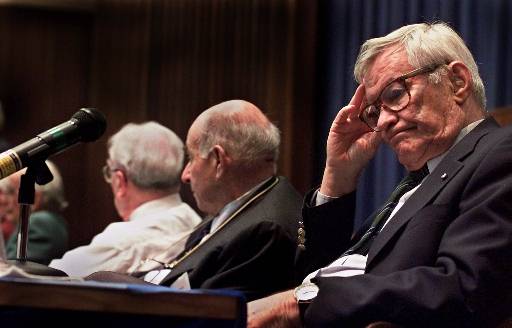Focusing on the issue of vagueness, the Supreme Court in Baggett v. Bullitt, 377 U.S. 360 (1964), struck down the 1931 and 1955 provisions of a Washington state law that mandated loyalty oaths for state employees, thereby interfering with their First Amendment rights of association.
University employees contested loyaly oaths
The 1931 statute, which applied only to teachers, required them to “promote respect for the flag and the institutions of the United States of America and the State of Washington.” The 1955 statute required all state employees to affirm that they were not “subversive” and that they were not aiding the Communist Party of the United States. Employees of the University of Washington had challenged both statutes.
Court said oath was too vague
Justice Byron R. White wrote the Court’s majority opinion, which limited its reach to the vagueness of the statutes. White relied in large measure on Cramp v. Board of Public Instruction (1961), which had invalidated a Florida loyalty oath. Like those who questioned that oath, White said that conscientious persons could not know for certain what the oath permitted and what it forbade.
He also pointed out that the 1931 oath might be applied to individuals who refused to salute the flag because of religious convictions. However well intentioned prosecutors or judges might be, reliance on their interpretation of the statutes would “not neutralize the vice of a vague law.” White further rejected the notion that the Court should abstain from handling the issue and wait on the state courts to do so. Although states had the right to “take proper measures safeguarding the public service from disloyal conduct,” the measures they take “must allow public servants to know what is and is not disloyal.”
Dissenters thought loyalty oaths had already been upheld
Writing in dissent, Justice Tom C. Clark, who was joined by Justice John Marshall Harlan II, denied the relevance of the Cramp decision. Clark thought the brief per curiam decision in Gerende v. Board of Supervisors of Elections (1951) was more on target. It had upheld an oath for individuals seeking a place on a ballot—they had to affirm they were not engaged in attempting to overthrow the government by force or violence.
In reviewing possible interpretations of the Washington oaths that his fellow justices had formulated, Clark accused them of extracting “more sunbeams from cucumbers than did Gulliver’s mad scientist” and building up “a whimsical and farcical straw man which is not only grim but Grimm.” In his view, the language of the Washington oaths differed little from that of the loyalty oaths required under the Smith Act of 1940, which the Court had upheld in Dennis v. United States (1951). Clark also dismissed claims based on claims of free speech and association as “frivolous.”
John Vile is professor of political science and dean of the Honors College at Middle Tennessee State University. He is co-editor of the Encyclopedia of the First Amendment. This article was originally published in 2009.

